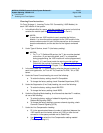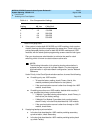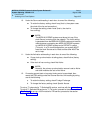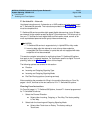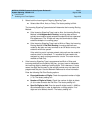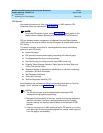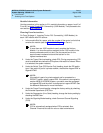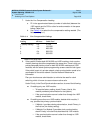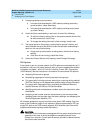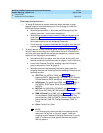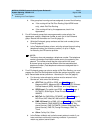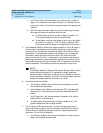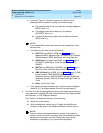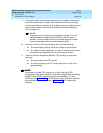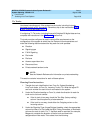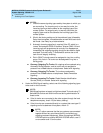
MERLIN LEGENDCommunications System Release 6.1
System Planning
555-661-112
Issue 1
August 1998
Lines/Trunks
Page 3-33Selecting Line/Trunk Options
3
9. If assigning backup synchronization:
a. In the box that describes the 100D module providing secondary
synchronization, check Secondary.
b. In the box that describes the 100D module providing tertiary back
up, check Tertiary.
10. Under the Source subheading in each box, do
one
of the following:
■ To retain the factory setting (that is, the system uses the clock of the
far-end connection), check Loop.
■ To change the setting (the clock is free-running), check Local.
11. The typical setup for the primary synchronization source is Active, and
other modules are set to Not Active. Under the Activation subheading in
each box, do
one
of the following:
■ If loop clock synchronization is taking place, check Active (factory
setting).
■ If the clock is free-running, check Not Active.
12. Under the Channel Service Unit heading, check Foreign Exchange.
PRI Options 3
If the switch is part of a private network, the PRI options are automatically set. If
the switch is not part of a private network, after you have completed the module
information on pages 1 and 2 of Form 3b, Incoming Trunks: DS1 Connectivity
(100D Module), use the instructions in this section to record these PRI options:
■ Assigning B-channels to groups
■ Associating outgoing and incoming services to the groups
■ For groups with incoming services, selecting an incoming routing method
(Dial Plan Routing or Line Appearance) and providing routing information
■ For groups with outgoing services, completing the Network Selection,
Special Services, and Call-by-Call Service tables
■ Identifying the trunk and telephone numbers sent to the network for caller
identification
■ Assigning a test number used for maintenance by the service provider,
changing timers and counters from the factory settings, and assigning the
Terminal Equipment Identifier (TEI)
All channels assigned to a group must be on the same 100D module. Also, the
order of the B-channel groups is not important. When programmed for PRI, the
single DS1 jack on the 100D module supports 23 B-channels (the Channel 24
superframe transmits signaling mode information).
!
CAUTION:
!
CAUTION:
The order in which channels are assigned within a group must be the exact
opposite of the order in which the telephone company’s switch hunts
through for a channel. Consult with the service provider to determine what
the correct order should be.



